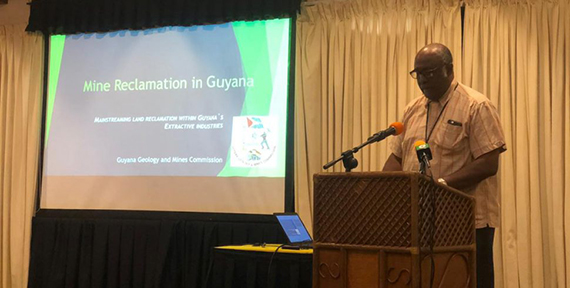Policy Forum Guyana (PFG), a civil society group, says that the Guyana Geology and Mines Commission (GGMC) is not institutionally fit for the task of environmental protection and this function should be assigned to another agency.
PFG in a statement on Saturday was reacting to a July 30th press conference by the GGMC where it talked up its mine reclamation and environmental protection efforts.
On its website, PFG describes itself as follows: “The Policy Forum Guyana … is a network of civic organizations which came into existence in 2015 with the general aim off strengthening electoral, environmental and financial accountability. Membership of the PFG currently comprises some twenty-two organizations covering trade union, indigenous, women, youth, transparency and faith-based organizations active in Guyana”.
PFG said that Guyanese concerned with the climate crisis would be dismayed at the size of the land restoration programme revealed on July 30 by the GGMC.
“Superficial understanding of restoration, non-enforcement, coupled with opaque finances, all point to an Agency unfit to protect the environment from the ravages of gold-mining In light of this situation the Policy Forum Guyana …is calling for fundamental re-structuring of legal, technical and administrative approaches to land restoration in which the GGMC should have a reduced role, operate more transparently and be subject to more rigorous oversight”, PFG said.
Citing GGMC Commissioner, Newell Dennison as stating on July 30 that reclamation was done by making land usable again by planting trees, refilling mining pits and clearing waterways, PFG said this was “startlingly superficial”. It said that such activities ought to be routinely undertaken by every miner and stringently enforced by GGMC.
“Abandoned mine-sites are silent bio-diversity graveyards; insect life is gone forever, animal species are hunted to extinction, water sources are polluted for years, communities life-styles are affected permanently. Their restoration is a major undertaking, far beyond the Commissioner’s description, which does even do justice to the limited work his Agency actually carries out”, PFG charged.
Dennison had said that in the past three years the GGMC ensured the reclamation of over 40 acres of land previously used for mining and spent approximately $100 million on the process.
He had pointed out that so far they have been able to reclaim 44 acres (17 hectares) of previously mined land through their reclamation process and other associated activities at Dakoura and Kara, Linden; Olive Creek, Mazaruni; and Mahdia and Saint Elizabeth, Potaro-Siparuni.
PFG’s statement on Saturday said that Dennison appeared to refer to the two pilot restoration schemes in Dakoura (Region 10) and Olive Creek ( Region 7).
“This is not restoration per se, these demonstration schemes are intended to test methods of physical restoration and to arrive at actual costs in order to implement more realistic environmental bonds and develop good practice among miners. An earlier pilot scheme at Frenchman’s Cove in Bartica established that small-scale restoration projects will cost a minimum of six million dollars”, PFG said.
It added that despite restoration being clearly an expensive undertaking, the GGMC was still only considering whether the bond value should be raised.
PFG noted that in accordance with Guyana’s Mining Regulations a bond requirement applies to “all categories of large, medium and small mining”. It pointed out that since the 1990s the environmental bond for medium-scale properties (up to 1200 acres in size) has been set at $100,000.
It pointed out that according to the Guyana Extractive Industries Transparency Initiative Report for Fiscal Year 2017 1,329 persons were allotted a total of 3,792 medium-scale permits between them covering some 5.7 million acres. Multiplying the $100,000 bond by this number of permits arrives at the sum of $379,200,000 which should have been gathered in 2017. It said that assuming the same calculations apply for the past three years, the total sum available for restoration should have been in the vicinity of $1 billion. It added that the cumulative figure since the 1990s would be enormous.
PFG charged that in addition to the failure to require adequate restoration by mining operators, mining and mining infrastructure are the biggest direct sources of lost revenue under the REDD+ programme. In 2017 alone mining and mining infrastructure was also responsible for degradation of 7,115 hectares of forest.
Mining in all Regions, including indigenous lands must be subject to rigorous regulation, the PFG argued, contending that there can be no exceptions to restoration requirements regardless of the ownership of lands.
It said that the need for an eco-system landscape approach to restoration is further underlined when sand-mining and quarrying are taken into account. It adverted to sand quarries along the length of both sides of the Linden highway, which combined with the massive logging trucks on the highway itself create effects which it said will become disastrous.
“PFG believes responsibility for environmental protection should be moved from GGMC to another agency charged with eco-system rehabilitation. This is much broader than reclamation and would include river ecosystems, sand and loam pits and access roads leading to mining intensive areas. The mandate of such an Agency would be to professionally assess environmental consequences of all kinds of mining activity so that realistic economic costs of restoration can be levied. This information should then feed into revised environmental requirements by the (Environmental Protection Agency) which should be progressively implemented by miners over the life of the mine from the on-set of mining activity, not when it’s finished. In this scheme of things the role of GGMC would then be to enforce compliance and technical quality assurance. The bond and whatever fine is imposed for non-compliance should be adequate for GGMC to finance the out-sourcing of the restoration work to licensed contractors”, the PFG declared.






